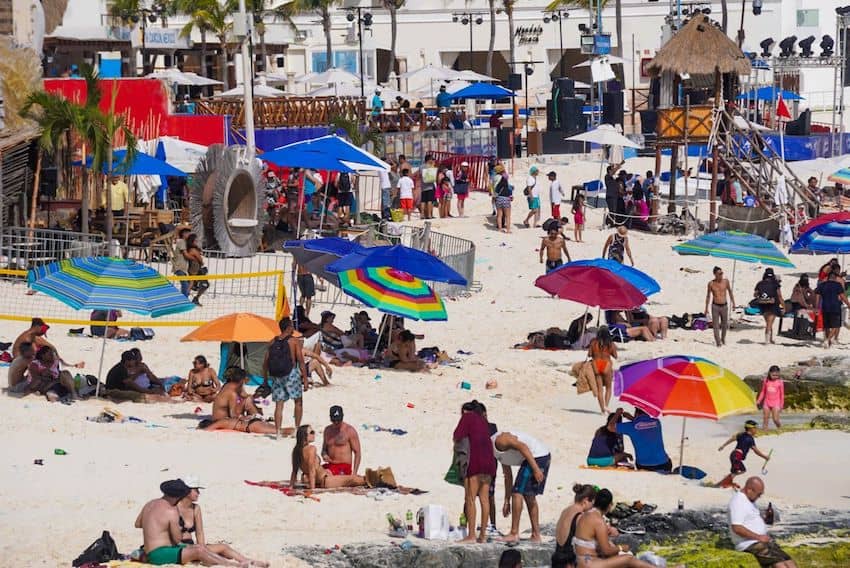Mexico is expected to attract 282 billion pesos (US $13.6 billion) from tourism during the Easter holiday, known locally as Semana Santa, or Holy Week, the Tourism Ministry (Sectur) reported on Monday. This marks an increase of 4.4% compared to the same period last year.
According to Sectur, an estimated 14.7 million tourists are expected to travel to Mexico’s various destinations during the upcoming vacation period, which spans Saturday, April 12 to Sunday, April 27.
📊 ¡La #SemanaSanta 2025 viene con todo!
Millones de turistas, derrama económica y ocupación hotelera se espera en los maravillosos destinos de nuestro país. 🇲🇽
¡Gracias a todas y todos los que hacen del turismo una fuerza que impulsa a México! 🌞🏖️✈️Te presentamos las… pic.twitter.com/WmdepDA6wI
— SECTUR México (@SECTUR_mx) April 8, 2025
The head of Sectur, Josefina Rodríguez Zamora, said the agency expects an average occupancy rate of 65.7% across Mexico, marking a 2.2% increase on the same period in 2024.
Meanwhile, popular beach destinations, traditional towns (pueblos mágicos) and traditional religious sites, such as Iztapalapa, Taxco, Morelia, Oaxaca and Los Remedios in México state, could see occupancy rates of up to 90%.
Sectur highlighted some of the destinations with the highest anticipated occupancy rates during Holy Week:
- Nuevo Nayarit: 88.3%
- Riviera Maya: 87.1%
- Cancún: 84%
- Puerto Vallarta: 82.7%
- Bahías de Huatulco: 80.2%
- Querétaro: 76.4%
- Monterrey: 76%
- Tecate: 75.6%
- Mérida: 72.7%
- Mazatlán: 71.4%
- Campeche: 69%
An estimated 6.57 million will stay in Mexico’s hotels during Easter, including around 4.85 million domestic tourists and 1.72 million foreign visitors, according to Sectur.
In addition to staying in hotels, approximately 7.46 million domestic tourists will stay with family and friends or in second homes. Meanwhile, around 716,000 international tourists are expected to use digital lodging platforms, such as Airbnb.
Income from lodging is expected to total around 15.6 billion pesos ($753.9 billion) during Holy Week, according to Rodríguez.
“These figures reflect tourist confidence in Mexico and the government’s commitment to maintaining a diverse, safe and competitive tourism offering,” said Rodríguez.
The businesses that will benefit the most from the influx of Easter tourism include lodging, transportation, restaurants, food vendors, stores and tourism service providers, including thousands of small and medium-sized businesses across Mexico.

Mexico City is expected to attract 21.27 billion pesos ($1 billion) in revenue during Holy Week, marking a 29.4% increase on the previous year, according to the National Chamber of Commerce, Services and Tourism of Mexico City.
Which beaches to avoid
Domestic and foreign visitors alike will be flocking to Mexico’s beaches during Holy Week. However, it is worth following the guidelines from the Federal Commission for the Protection against Sanitary Risks (Cofepris), which has deemed six Mexican beaches unfit for tourists due to coastal sewage pollution.
Cofepris assessed over 2,000 samples of seawater collected at 393 locations for its Clean Beaches 2025 water quality monitoring program. It found that 98% of beaches in Mexico met the necessary standard for recreational use: fewer than 200 MPN (Most Probable Number) fecal enterococci in 100 ml of water. However, six beaches were found to exceed acceptable levels of fecal enterococci.
The beaches Cofepris deemed contaminated include Rosarito and Rosarito I, as well as Tijuana and Tijuana I in Baja California, Icacos Beach in Acapulco, Guerrero and Sayulita in Bahía de Banderas, Nayarit.
While Oasis Beach in Puerto Vallarta, in the western Mexican state of Jalisco, exceeded the acceptable level in Cofepris’s December 2024 assessment, it has since met the standard for recreational use.
With reports from El Financiero, Debate and Informador
